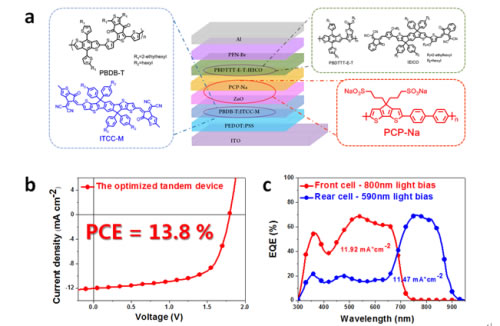(a) Molecular structure of materials used for high-efficiency laminated device front cells, rear cells, and intermediate connection layers. (b) Laminated device JV curve. (c) Stacked device EQE curve. The stacked device structure can effectively broaden the photoresponse range of the solar cell, and has an important application in improving the photoelectric conversion efficiency (PCE) of various types of photovoltaic cells. Compared to single-junction cells, tandem cells involve more types of photoelectrically active and electrode-modified layer materials, and have more complicated device structures. It is a very challenging task to realize high-efficiency stack cell materials and device preparation. work. In terms of key materials, high-efficiency stacked organic solar cells require sub-cell active layer materials having wider and narrower optical band gaps, respectively, and an intermediate connection layer material for connecting the sub-cells. Wide-bandgap subcells are used to absorb high-energy short-wavelength solar light and are easy to realize high open-circuit voltages. However, because of the unsatisfactory energy level arrangement of materials, most existing wide-bandgap organic photovoltaic active layer materials are open circuits. The voltage is significantly lower than the theoretical value. The narrow optical bandgap sub-cell is used for absorbing low-energy long-wave solar light, and is easy to obtain a higher current density. The existing external quantum efficiency of the narrow bandgap organic photovoltaic active layer is low, and the significantly limited current density is improved. In addition, in the design of stacked devices, the lack of complementarity between the absorption spectra of the subcells is also a bottleneck that limits their efficiency. For many years after successful preparation of organic laminate batteries, the highest photoelectric conversion efficiency of such batteries has been maintained by foreign research institutes. Researcher Hou Jianhui of the Polymer Physics and Chemistry Laboratory of the Institute of Chemistry, Chinese Academy of Sciences Researchers have conducted extensive research on the preparation of key materials and devices for stacked organic photovoltaic cells. First, the researchers centered around polymer-fullerene-based organic photovoltaic cells, which optimized the photovoltaic activity of the wide band gap (Adv. Mater. 2014, 26, 5880) and the narrow band gap (Chem. Mater. 2014, 26, 3603). The layer materials and the corresponding method for the preparation of stacked devices achieved 10% and 11% of photovoltaic efficiency in 2015 and 2016, respectively (Adv. Mater. 2015, 27, 1189; Adv. Mater. 2016, 28, 5133). To reach the international advanced level. The researchers used the team's accumulation in polymer-non-fullerene organic photovoltaic cells to optimize non-fullerene wide and narrow band gap materials and cell preparation methods, respectively, to achieve open-circuit voltages in excess of 1V in wide-bandgap cells. (Adv. Mater. 2017, 29, 1700254), a short-circuit current density of more than 20 mA/cm2 is realized in a narrow bandgap battery (Adv. Mater. 2016, 28, 8283). Based on this, the team further developed a neutral conductive polymer electrode modification material for preparing a connection layer between laminated cell subcells (Adv. Mater. 2016, 28, 434; Macromolecules 2016, 49, 8126), successfully constructed High-efficiency stacked devices. When one of the two subcells in the laminate cell is a fullerene acceptor, the photoelectric conversion efficiency of the laminate cell exceeds the highest value reported in the literature, reaching 12.8% (Adv. Mater. 2017, 29, 1606340). When the non-fullerene type photovoltaic active layer sub-cells were used, the battery efficiency achieved a further breakthrough, reaching 13.8% (J. Am. Chem. Soc. 2017, 139, 7302). This result significantly exceeds the highest reported results, creating a new world record for stacked organic photovoltaic cells. The research work was supported by the Chinese Academy of Sciences and the National Natural Science Foundation of China.
Aluminum Diamond Plate 3003-H22 is easy to fabricate and its raised diamond pattern provides good slip resistance and walking stability.
Application and uses of Aluminum diamond tread plate 3003-H22 bright are: extensive product use as scuff plates, running boards, and mud flaps for fire engines, ambulances, fire trucks, trailers and toolboxes, recreational, and four-wheel-drive vehicles.
Aluminum Diamond Plate Aluminum Diamond plate sheet Xiaoxian RuiYi Commercial Trade Co.,Limited , https://www.ryaluplate.com